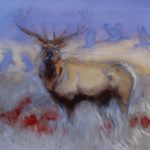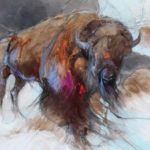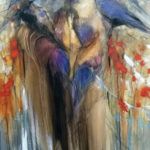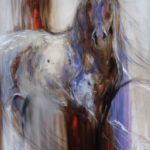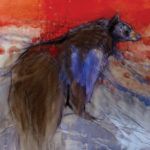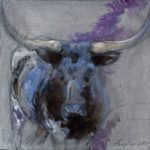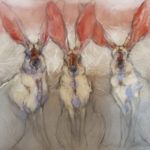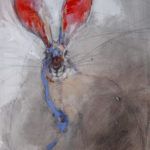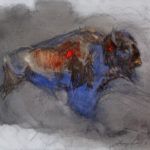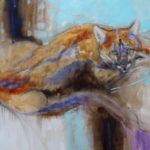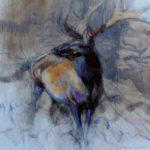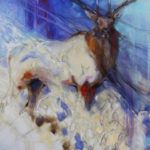Amy Lay honors wild creatures in her contemporary paintings
By Bonnie Gangelhoff
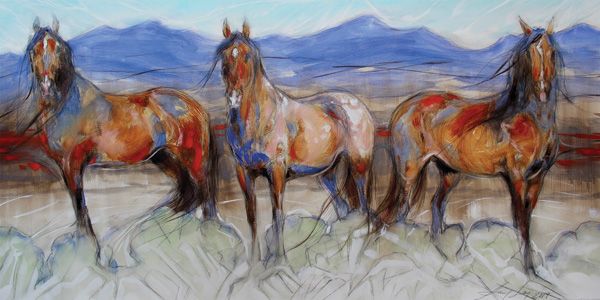
Amy Lay, Beneath the Blue Mountains, oil/charcoal, 24 x 48.
This story was featured in the June 2020 issue of Southwest Art magazine. Get the Southwest Art June 2020 print issue or digital download now–then subscribe to Southwest Art and never miss another story.
A MAMMOTH bison lumbers across the landscape as ominous gray clouds gather behind him. Swirling lines throughout the composition seem to imply that a strong, gusty wind is kicking up. The moody scene suggests a reckoning of sorts between two powerful forces in nature: a building thunderstorm on one side, and a mighty animal on the other. This evocative painting by Amy Lay, titled REBEL, was on view in early March at the annual NatureWorks Art Show and Sale in Tulsa, OK.
For Lay, the painting and its title hold special meaning, offering an appropriate metaphor for how she sees challenges in her life and art. “The title for REBEL came quickly to me,” she says. “Being in this world requires a bit of a rebellious attitude, even if you are part of a herd, too. I always liked the idea of being a fighter, being a force against the storms.”
- Amy Lay, Antlers and Indian Paintbrush, oil/charcoal, 36 x 48.
- Amy Lay, Rebel, oil/charcoal, 48 x 60.
- Amy Lay, Teach Me the Raven Ways, oil/charcoal, 72 x 36.
Lay also associates REBEL with the road trip she took from the Oklahoma show back to her Oregon ranch, a journey she won’t soon forget. As she and her husband, Thomas, drove across nine states, word of the new coronavirus was spreading over the country. “There was this impending threat of the virus on the news every day,” Lay says. “It felt like we were racing home, and every day it felt like a heavier storm was coming. The experience was surreal. We visited galleries and clients along the way. At the start of the trip we gave people big hugs, and at the end of the trip we weren’t even able to shake hands with folks.”
When we caught up with Lay, she was settled back into her ranch in rural northeastern Oregon. The world had turned upside down in a week. “For this story, I wanted to choose some paintings that would convey strength and courage for people given the difficult times,” she says. “REBEL was one of those pieces that just flowed from the moment I touched pencil to canvas. I wanted to convey strength with the powerful form and charcoal lines. I wanted REBEL to empower people.”
Like everyone else these days, Lay is contending with the new normal. Several of her upcoming shows are in limbo due to public health concerns. And one of her favorite paintings, TEACH ME THE RAVEN WAYS, is currently hanging at the Booth Western Art Museum in Cartersville, GA, which was still closed at press time.
TEACH ME THE RAVEN WAYS is a quintessential example of Lay’s work—loose and ephemeral, punctuated with bold splashes of color. The painting depicts a bear surrounded by a coven of ravens. The vibrant piece showcases the artist’s current interest in combining multiple species in one composition—she knits the ravens and the bear together almost as if they were one creature. Lay says that was intentional: She realized that the bear’s shoulder was the perfect space for a raven’s neck, and the other individual shapes also seem to fit together like puzzle pieces. “I posed and intertwined their forms with pencil lines and shared colors,” Lay says. “I wanted to convey a feeling of unity and understanding between the bear and the ravens, like they each have something to share that could benefit the others, if they will only listen.”
- Amy Lay, The Roan, oil/charcoal, 40 x 30.
- Amy Lay, Ursine, oil/charcoal, 48 x 52.
- Amy Lay, Blue Babe, oil/charcoal, 8 x 8.
LAY WAS born in 1972 and grew up on the edge of Oregon’s Wallowa Mountains, where sagebrush meets forest. Her great-grandparents arrived here to homestead in 1892, and she is part of the fourth generation of her family to call the land home. “We’ve been here over a century, and we are still holding on,” she says.
As a young girl Lay had two passions: drawing and taking care of orphaned critters she discovered in the wild. She was fond of smuggling baby starlings, squirrels, snakes, and weasels into her bedroom in buckets and boxes. Her mother was patient even though she disapproved, especially when the critters found a way into the kitchen or living room. “I felt if I could raise them and form a bond, I could keep them and let them go lat-er,” Lay says. “My love of animals is innately part of me. As a child I was a captive audience to their amazing show. What I learned from them has been priceless for my career. I learned the mannerisms, the direction of the fur and feathers, how they are jointed, the way they look at us, and most importantly, the way they move.”
Lay says she was never much of a reader as a child, but when it came to art, she saw every open space as a possible canvas for her talents. On one occasion Lay covered her bedroom walls with images of horses. Another time she stirred up the ire of her older brother by drawing horses in magic marker all over his favorite Bee Gees album cover.
A defining experience in Lay’s young artistic life happened when she was 13 and accompanied her father on a business trip to Jackson, WY. While her father met with clients, the wide-eyed teenager strolled around the downtown square. What she witnessed amazed and delighted her: “I had never been to a place where there were galleries and to a place that actually fostered art,” Lay recalls. “I said to myself, ‘I can do this someday.’”
- Amy Lay, Jackrabbit Blush, oil/charcoal, 18 x 24.
- Amy Lay, Icon, oil/charcoal, 40 x 30.
- Amy Lay, Blush, oil/charcoal, 12 x 9.
It was no surprise to her family that, when it came time for college, she chose fine art as her major, eventually graduating in 1994 with a bachelor’s degree from Eastern Oregon University. In the early years of her career as a wildlife artist, Lay struggled to fit in with the photorealistic style favored by many artists working in the genre. She found the tight, traditional style confining, like an ill-fitting suit of armor. She ultimately re-belled and decided that her imagery would spring from her imagination and memories. “I’ve been gathering reference material my whole life,” she says. “If I have a camera in the field, it gets in the way. I miss the moment.”
After she married, Lay continued creating art while raising a family and working as a social-studies teacher at the local high school. Three days a week she stayed up until 2 a.m. to paint, slept for three hours, and rose at 5 a.m. to get herself and her three children ready for the school day. But by 2008, Lay wanted a change in the routine. Although she loved teaching, she longed to devote more time to her artwork. She made a pact, promising herself that if she started to earn as much money from her art as she did as a teacher, she would quit her day job. That moment arrived in 2010. After painting miles of canvas and working into the wee hours of the morning, gallery representation and invitations to shows began to come her way. In particular, her artistic life took a meaningful turn, she says, after she was invited to the annual Plantation Wildlife Art Festival in Georgia. “This show gave me confidence, and I threw my hat in the ring,” she says.
TODAY LAY works in a new studio, a work-in-progress as she and her husband remodel an outbuilding a few steps from their home. She prefers to keep the space simple; its main features are a plank floor and a north window overlooking a downward slope of ponderosa pines. She is not without company or accompaniment while she draws and paints: Spring days bring the chirping of western bluebirds and violet-green swallows, and in the evenings the frogs and coyotes sing and howl. “My workspace is truly a little piece of heaven,” Lay says.
- Amy Lay, Ruffian, oil/charcoal, 8 x 10.
- Amy Lay, Shadow Queen, oil/charcoal, 30 x 40.
- Amy Lay, Still Moment, oil/charcoal, 20 x 20.
On this particular day her easel holds a painting depicting donkeys, birds, and jackrabbits that is scheduled to hang at Manitou Galleries in Santa Fe. The artist once worked exclusively in watercolor, but these days she creates primarily with oil, graphite, and charcoal. She is known for energetic lines that convey movement, even when she is capturing and freezing a single moment in time. For Lay, nothing in nature is ever completely still or stagnant. Cyndi Hall, associate director at Manitou Galleries, says the artist has a special talent for incorporating opposites in her artwork. “It’s almost an oxymoron—her work feels whimsical but also very engineered at the same time,” Hall says. “At the gallery we love the multiple draft lines that are extremely purposeful in her work.”
Indeed, Lay considers line a key element in her work; a primary source of her inspiration are the cave paintings at Altamira in Spain and Lascaux in France. “The works are pure and bold with gorgeous line and movement, and most of all, these unknown artists knew the animals. It shows. More beautiful lines I have never seen.”
As this story was going to press in April, the state of New Mexico was under a stay-at-home order that closed nonessential businesses. But Lay’s show at Manitou Galleries, with sculptor Jeremy Bradshaw, will go on, even if it’s completely virtual, Hall says: “These artists have worked very hard to complete their work, and it needs to be seen. Art is essential.”
Lay agrees. She has worked hard and is excited about her group of paintings. Summing up her goals, she says, “I want to make the animals rock stars. I want them to be honored and considered important to us. I think about the lack of voice among the natural world, or maybe it’s just that we can’t always hear it. I feel my calling is to amplify nature’s voice.”
representation
Manitou Galleries, Santa Fe, NM; Mountain Trails Gallery, Park City, UT, and Jackson, WY; Montana Trails Gallery, Bozeman, MT; Horton Fine Art, Beaver Creek, CO; Tilting at Windmills Gallery, Manchester, VT.
- Amy Lay, Swallowtail Bull, oil/charcoal, 40 x 30.
This story was featured in the June 2020 issue of Southwest Art magazine. Get the Southwest Art June 2020 print issue or digital download now–then subscribe to Southwest Art and never miss another story.
MORE RESOURCES FOR ART COLLECTORS & ENTHUSIASTS
• Subscribe to Southwest Art magazine
• Learn how to paint & how to draw with downloads, books, videos & more from North Light Shop
• Sign up for your Southwest Art email newsletter & download a FREE ebook






